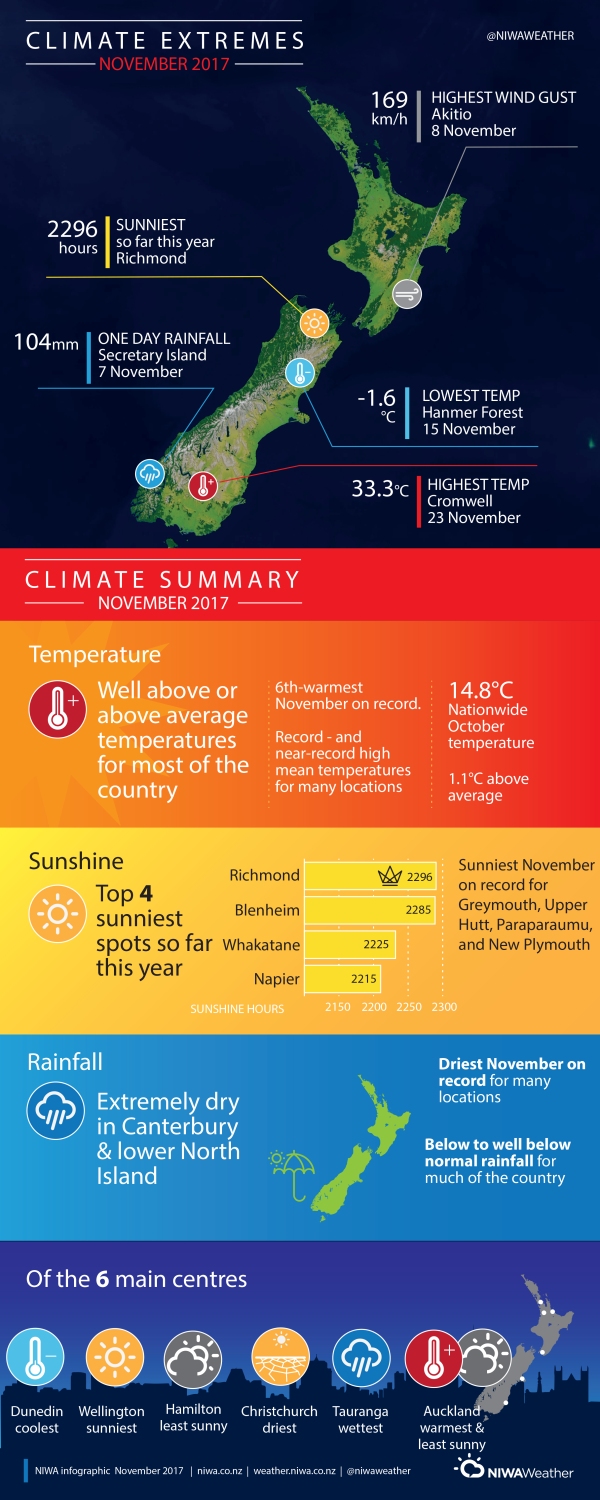Hot in the south and dry countrywide to end spring.
Overview
November 2017 was characterised by higher than normal sea level pressure over New Zealand and the surrounding seas, particularly to the south of the country. This pressure setup, consistent with La Niña conditions, resulted in a long period of dry, settled, and very warm weather across the country during the second half of the month.
Several locations across the South Island and lower North Island observed exceptional dryness and, in some cases, came close to or broke rainfall records that had stood for over a century. Therefore, soil moisture levels decreased significantly across country, particularly during the second half of the month. At the end of November, the driest soils compared to normal for the time of year were found in the western part of both Islands. Low rainfall and very dry soils are concerning both from a meteorological and hydrological perspective, especially as New Zealand is heading into what is usually the driest season of the year.
The persistence of higher than normal pressure also resulted in warmer than average temperatures over much of the country during the month and contributed to long periods of tranquillity
In turn, sea surface temperatures (SSTs) in New Zealand coastal waters, the Tasman Sea, and near eastern Australia soared to record or near-record levels. SSTs were generally 1 to 3°C above average for the time of year and up to 6°C above average in some areas.
Due to the persistent ridge of high pressure, it was a sunny month across much of the South Island and western North Island. Most areas recorded above normal or well above normal sunshine. However, normal or below normal sunshine hours were recorded in the northeast of the North Island.
Further Highlights:
- The highest temperature was 33.3°C, observed at Cromwell on 23 November.
- The lowest temperature was -1.6°C, observed at Hanmer Forest on 15 November.
- The highest 1-day rainfall was 104.4 mm, recorded at Secretary Island on 7 November.
- The highest wind gust was 169 km/h, observed at Akitio on 8 November.
- Of the six main centres in November 2017, Auckland was the warmest, Auckland and Hamilton were the least sunny, Dunedin was the coldest, Christchurch was the driest, Wellington was the sunniest, and Tauranga was the wettest.
- Of the available, regularly reporting sunshine observation sites, the sunniest four locations in 2017 so far (1 January – 30 November) are Richmond (2296 hours), Blenheim (2285 hours), Whakatane (2225 hours) and Lake Tekapo (2215 hours).
Download
- November 2017 Climate Summary information [PDF 750KB]
- November 2017 Climate statistics [PDF 65KB]
Contact
Ben Noll, Meteorologist Tel. 09 375 6334
Details
|
Rainfall |
Rainfall was well below normal (<50% of normal) for much of Canterbury, the West Coast, Tasman, Nelson, Marlborough, Wellington, Wairarapa, Manawatu-Whanganui, parts of Hawke’s Bay, Auckland, and Bay of Plenty. Isolated pockets of above normal (120-149% of normal) rainfall occurred in Northland, the Queenstown-Lakes District, and about Roxburgh (Central Otago). Rainfall was below normal (50-79% of normal) or below normal (80-119%) elsewhere. |
|
Temperature |
Temperatures were well above average (>1.20°C of average) in parts of Southland, interior Otago, interior Canterbury, the West Coast, and interior Waikato. Temperatures were above average (0.51-1.20°C above average) for most of the rest of the country, except for some eastern coastal areas of both Islands that recorded near (-0.50°C to +0.50°C of average) average temperatures. |
|
Sunshine |
Sunshine was well above normal (>125% of normal) or above normal (110-125% of normal) for much of the South Island and western North Island. Sunshine was near normal (90-110% of normal) for most other parts of the country, except for areas in Gisborne, Bay of Plenty, Coromandel Peninsula, and Northland where sunshine was below normal (75-89% of normal). |
|
Soil Moisture |
As of 1 December, soils were significantly drier than normal for the time of year across a large portion of the South Island, particularly in the west, as well as the lower and western North Island. Soil moisture was slightly below normal or near normal in Central Otago, the Central Plateau, Gisborne, Coromandel Peninsula, and northern Northland. Soil moisture was near or above normal in the Aupouri Peninsula and Great Barrier Island. |

